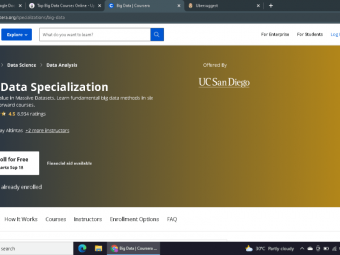Lpic 1 Exam 102 V5 System Administrator Certification
65 Assignments, 2 Practice tests (containing 67 questions in total), 15 Lectures
Last updated 2022-01-10 | 3.9
- By completion of the course- the students will be prepared to take the second exam (exam 102) of the LPIC-1: System Administrator Certification
What you'll learn
* Requirements
* The students should have basic knowledge of Linux* It is recommended that all assignments are completed in a Virtual Linux Installation.
Description
The TEST4U course for LPIC-1 (Exam 102 v5): System Administrator Certification
The TEST4U team realized that there is a need for a complete hands-on Training system for the LPIC-1 (Exam 102 v5), so we created the LPIC-1 (Exam 102 v5): System Administrator Certification, course. It is targeted to people, who want to succeed in the LPIC-1 (Exam 102 v5).
The Course at a glance
In this course you will find:
65 assignments properly categorized
65 Solutions for every assignment
1 compressed file for all of the above assignments
67 Practice test questions
15 lectures
The Course in detail
65 assignments properly categorized
In this course you will practice on the following categories:
1. Shells and Shell Scripting
2. User Interfaces and Desktops
3. Essential System Services
4. Administrative Tasks
5. Networking Fundamentals
6. Security
1 compressed file for all of the above assignments
Each and every assignment comes with its distinct files, contained in 1 compressed file, downloaded during the first assignment
65 Solutions for every assignment
All assignments are accompanied by solutions. We recommend you try to solve the assignments without viewing the solution. This way you will better understand your limitations and be able to focus on them. You can then see the solution after you have solved it, to know if you answered the question correctly.
Fast feedback from our instructors
We give feedback to all assignments, usually within one or two working days. Although in many cases we have been known to answer within a few hours.
In this course we have focused on the practical side. What does that mean? That almost all the content you will find in this lecture is in the form of assignments. You will gain practical, hands-on experience by solving these assignments and you will get feedback by uploading them in the Udemy platform.
We are involved in the IT Training field since 2003 and have successfully trained almost a million students. Our focus to the practical side of education has proven to be a lot more effective than just reading a book or watching a lecture.
Our accumulated experience led us in developing an interactive training tool in order to promote self-learning and self-improvement when it comes to IT skills. This tool is called TEST4U and we firmly believe that it will help you achieve your goals; therefore, we created a couple of lectures dedicated to TEST4U. After all, close to a million students have trusted TEST4U for a good reason!
Who this course is for:
- Students preparing for the second exam (exam 102) of the LPIC-1: System Administrator Certification
Course content
9 sections • 84 lectures
Introduction Preview 01:14
Install Linux in a Virtual Machine Preview 07:50
Before you submit an assignment Preview 01:22
Download the assignment files
Before proceeding to this assignment make sure you have created the virtual Linux installation as shown in the previous lecture.
Introduction to Shells and Shell scripting (Topic 105) Preview 03:42
105.1 Customize and use the shell environment
What is a shell?
Shell is a text-based program that acts as an interface between the user and the computer. It also allows the user to interact with the kernel.
Another task of a shell is to provide the environment where a user can execute scripts.
Since Linux is probably the most adaptable operating system, many different shells were released over the time, to meet the users’ needs.
Some of the most known shells are:
· bash
· sh
· ksh
· zsh
· csh
In this exam all tasks are based only on bash shell.
You should be able to
· customize the shell environment by modifying global and user-specific settings
· set environment variables when a user logs in
· create aliases and functions for frequently user commands and tasks
· maintain skeleton directories for new user accounts.
105.2 Customize or write simple scripts
Aliases and functions are very useful and may save you a lot of time. But there are limits in what you can do. Using shell scripting there are limitless possibilities in task automation.
The main goal of this section is to learn how to write simple bash scripts using commands you already know. The standard sh syntax will be used.
You have to be familiar with the shebag line (#!) of a script, which determines the script interpreter. For example, if a script starts with the #!/bin/bash line, it means that the following commands will interpreted by the bash interpreter.
It is also mandatory to know how to concatenate commands and designate the execution of a command depending on the result of another.
Check the following
command1 || command2:
if the command1 fails, then the command2 will be executed
command1 && command2:
the command2 will executed only if the command1 succeeds
command1; command2:
both commands will be executed
The loops and the if-statements are also part of the exam. You should be able to understand them and use them.
Here is a simple script that sums all numbers passed as arguments in the script:
Finally, you should be able to set the ownership and the correct execution rights to a script so they can be executed by whoever you choose.
Introduction to User Interfaces and Desktops (Topic 106) Preview 01:47
106: User Interfaces and Desktops
In this section you have to get familiar with the X11, its architecture, and how to install and configure it.
Your understanding on the X-Window configuration file and the ability to override some basic settings of it, will be probably tested in the exam.
Understand the components of desktop environments, such as display manager and window manager
Manage access to the X server and view applications running on remote servers
106.2 Graphical Desktops
This section is more or less informative. You should be aware of the existence of graphical desktops, the ability to access them remotely and the protocols that are used to achieve it.
The most common desktop environments are KDE, GNOME and Xfce.
The most common remote desktop protocols are XDMCP, VNC, RDP, SPICE
106.3 Accessibility
This section is also an informative one. You should be aware of the existence of the accessibility settings and the assistive techniques like:
· Braille display
· Screen magnification
· On screen Keyboard
· Voice recognition
· "Sticky" and repeat keys
Questions on Topics 105 and 106 Preview 01:22
75237
Make sure you have read the article "Before you submit an assignment" (Lecture 3) before proceeding to solve this assignment.
75238
Make sure you have read the article "Before you submit an assignment" (Lecture 3) before proceeding to solve this assignment. This question requires preparation.
75239
Make sure you have read the article "Before you submit an assignment" (Lecture 3) before proceeding to solve this assignment.
75242
Make sure you have read the article "Before you submit an assignment" (Lecture 3) before proceeding to solve this assignment.
75243
Make sure you have read the article "Before you submit an assignment" (Lecture 3) before proceeding to solve this assignment.
75245
Make sure you have read the article "Before you submit an assignment" (Lecture 3) before proceeding to solve this assignment.
75246
Make sure you have read the article "Before you submit an assignment" (Lecture 3) before proceeding to solve this assignment. This question requires preparation.
75249
Make sure you have read the article "Before you submit an assignment" (Lecture 3) before proceeding to solve this assignment.
Introduction to Administrative Tasks Preview 02:11
107.1 Manage user and group accounts and related system files
This is a very important section for the exams.
You should practice on managing users and groups, manage user and group databases, and limit user accounts.
To be more specific you should be able to:
· Create, modify, lock, unlock, delete user accounts
· Change password to user accounts
· Create, modify, delete groups
· Set password to groups
· Add users to one or more groups
· Understand the files /etc/passwd, /etc/shadow, /etc/group, /etc/gshadow,
107.2 Automate system administration tasks by scheduling jobs
Another important section is scheduled jobs.
There are three ways to schedule a job:
· crontab
· at
· systemd timers
You should be able to schedule a script to run in the future, using any of the above mentioned ways.
As for crontab, you should know how to create system wide cronjobs and cronjobs for the current user. The knowledge of the /etc/crontab structure and the meaning of each job’s fields is mandatory and very often is part of the exams.
107.3 Localization and Internationalization
This section is dedicated to system language and regional settings.
You should be able to identify the system’s locale and time zone settings as well as modify them if needed.
The environment variables that are related with localization are also very important to know when getting ready for the exam.
The character encodings are also part of this section. Most important encodings are: ASCII, ISO-8859, UTF8 and Unicode.
Questions on Administrative Tasks Preview 01:18
75266
Make sure you have read the article "Before you submit an assignment" (Lecture 3) before proceeding to solve this assignment.
75267
Make sure you have read the article "Before you submit an assignment" (Lecture 3) before proceeding to solve this assignment.
75269
Make sure you have read the article "Before you submit an assignment" (Lecture 3) before proceeding to solve this assignment.
75270
Make sure you have read the article "Before you submit an assignment" (Lecture 3) before proceeding to solve this assignment.
75271
Make sure you have read the article "Before you submit an assignment" (Lecture 3) before proceeding to solve this assignment.
75272
Make sure you have read the article "Before you submit an assignment" (Lecture 3) before proceeding to solve this assignment.
75273
Make sure you have read the article "Before you submit an assignment" (Lecture 3) before proceeding to solve this assignment.
75274
Make sure you have read the article "Before you submit an assignment" (Lecture 3) before proceeding to solve this assignment.
75275
Make sure you have read the article "Before you submit an assignment" (Lecture 3) before proceeding to solve this assignment.
75277
Make sure you have read the article "Before you submit an assignment" (Lecture 3) before proceeding to solve this assignment.
75279
Make sure you have read the article "Before you submit an assignment" (Lecture 3) before proceeding to solve this assignment. This question requires preparation.
75280
Make sure you have read the article "Before you submit an assignment" (Lecture 3) before proceeding to solve this assignment. This question requires preparation.
75282
Make sure you have read the article "Before you submit an assignment" (Lecture 3) before proceeding to solve this assignment.
75283
Make sure you have read the article "Before you submit an assignment" (Lecture 3) before proceeding to solve this assignment. This question requires preparation.
75284
Make sure you have read the article "Before you submit an assignment" (Lecture 3) before proceeding to solve this assignment.
75285
Make sure you have read the article "Before you submit an assignment" (Lecture 3) before proceeding to solve this assignment.
75286
Make sure you have read the article "Before you submit an assignment" (Lecture 3) before proceeding to solve this assignment.
75287
Make sure you have read the article "Before you submit an assignment" (Lecture 3) before proceeding to solve this assignment.
75288
Make sure you have read the article "Before you submit an assignment" (Lecture 3) before proceeding to solve this assignment.
75293
Make sure you have read the article "Before you submit an assignment" (Lecture 3) before proceeding to solve this assignment.
75299
Make sure you have read the article "Before you submit an assignment" (Lecture 3) before proceeding to solve this assignment.
Introduction to Essential System Services (Topic 108) Preview 03:01
108.1 Maintain system time
Most of the systems have two clocks: a hardware clock (RTC – Real time clock) and a software clock. When the system is powered off, the hardware clock takes care of keeping the correct time.
You should be able to:
· adjust the system time and date
· set the time of the hardware clock to the correct UTC time
· set the software clock in accordance to the hardware clock
· change the time zone
· do basic configuration using ntpd and crony
· sync the time using the pool.ntp.org time server
· understand the use of ntpq command
As crony is new on the exams syllabus, you should go a little deeper in it. There will probably be a question on it.
108.2 System Logging
System logging is another beloved topic in exams.
You have to be aware of four logging daemons for linux:
syslogd
syslog-ng
rsyslog
journald
You have to be aware of the existence of the first two, but for the exam you have to focus on the last two of them: rsyslog and journald. Their configuration is also part of the syllabus.
To be ready after completing this section you should be able to:
· Understand rsyslog components: facility, level and action
· Configure basic settings of rsyslog
· Configure systemd journal size and storage
· Query the systemd journal and filter the results by date, priority etc
· Clear old logs
· Configure logrotate and schedule it to run in a regular basis
108.3 Basics of Mail Transfer Agents (MTAs)
You will be asked only for the programs that exist already and the ability to set simple aliasing and forwarding configurations.
Some known MTAs are Postfix, Sendmail and Exim.
To be ready for the exam you should also know how to create aliases and edit the .forward file in order to forward your email to another address.
108.4 Manage printers and printing
Key items where you should focus in this section is:
· Basic CUPS configuration (for local and remote printers)
· Manage user print queues
· Troubleshoot general printing problems
· Add and remove jobs from configured printer queues
· lpd legacy interface (lpr, lprm, lpq)
Questions on Essential System Services Preview 01:42
75259
Make sure you have read the article "Before you submit an assignment" (Lecture 3) before proceeding to solve this assignment.
75278
Make sure you have read the article "Before you submit an assignment" (Lecture 3) before proceeding to solve this assignment.
75295
Make sure you have read the article "Before you submit an assignment" (Lecture 3) before proceeding to solve this assignment.
75324
Make sure you have read the article "Before you submit an assignment" (Lecture 3) before proceeding to solve this assignment.
75350
Make sure you have read the article "Before you submit an assignment" (Lecture 3) before proceeding to solve this assignment.
75351
Make sure you have read the article "Before you submit an assignment" (Lecture 3) before proceeding to solve this assignment.
75352
Make sure you have read the article "Before you submit an assignment" (Lecture 3) before proceeding to solve this assignment.
75357
Make sure you have read the article "Before you submit an assignment" (Lecture 3) before proceeding to solve this assignment.
75365
Make sure you have read the article "Before you submit an assignment" (Lecture 3) before proceeding to solve this assignment.
75367
Make sure you have read the article "Before you submit an assignment" (Lecture 3) before proceeding to solve this assignment.
Introduction to Networking Fundamentals Preview 03:02
109.1 Fundamentals of internet protocols
You should be able to understand the TCP/IP network fundamentals. It is an important section and one you have to deeply dive in.
Starting with DoD model, you should know its four layers and the protocols that are used in each one:
· Layer 4: Process Layer (TTP, FTP, SMTP, DNS, Telnet)
· Layer 3: Host-to-Host Layer (TCP, UDP)
· Layer 2: Internet Layer (IPv4, IPv6, RIP, OSPF, ARP, IGMP, ICMP)
· Layer 1: Network Access Layer (Ethernet, MAC, HDLC, PPPoE)
For the exam you should study layers 1~3 and their protocols.
In the internet layer, to achieve the packet/datagram delivery to the correct application, network applications, use ports. Each application has its own port. There is a total of 65,536 ports available. The first 1,024 ports are called Well Known Ports. Here is a list with the most common TCP and UDP ports that you should know for the exam.
Another important objective in this section is IP-Classes.
You have to know that there are five classes. The Class D is reserved for multicast and the Class E is reserved for experimental purposes.
Foreach class you should know the starting and the ending addresses, the standard network mask and the assigned address range for private networks.
Important:
The 127.0.0.0/8 network is the loopback network that a computer uses for internal communication within the same machine. Usually the IP address 127.0.0.1 is used for the loopback device.
The network with the address 169.254.0.0/16 is used for automatic addressing in home networks (APIPA).
Other objectives that are discussed in this section are
network masks
CIDR notation
gateways
broadcast addresses
IPv6 addresses.
109.2 Persistent network configuration
By completing this section, you should be able to:
· understand the TCP/IP host configuration,
· configure the ethernet and Wi-Fi connections using the NetworkManager
· Know about systemd-networkd
Your aim should be to successful manage the persistent network configuration of a Linux host.
109.3 Basic network troubleshooting
This section aims at troubleshooting the network issues. You should be able to view and manually configure the network interfaces as well as to view and manually configure the routing tables of the machine.
Using tools like ping, traceroute, tracepath, netcat, ifconfig, netstat, route you should be able to debug network connectivity issues.
109.4 Configure client-side DNS
In this part of the syllabus you will learn how to cope with a DNS server.
Be sure you can query any remote DNS server and configure the local name resolution so you can use remote DNS servers
Questions on Networking Fundamentals Preview 01:47
75264
Make sure you have read the article "Before you submit an assignment" (Lecture 3) before proceeding to solve this assignment.
75314
Make sure you have read the article "Before you submit an assignment" (Lecture 3) before proceeding to solve this assignment.
75315
Make sure you have read the article "Before you submit an assignment" (Lecture 3) before proceeding to solve this assignment.
75323
Make sure you have read the article "Before you submit an assignment" (Lecture 3) before proceeding to solve this assignment.
75326
Make sure you have read the article "Before you submit an assignment" (Lecture 3) before proceeding to solve this assignment.
75327
Make sure you have read the article "Before you submit an assignment" (Lecture 3) before proceeding to solve this assignment.
75328
Make sure you have read the article "Before you submit an assignment" (Lecture 3) before proceeding to solve this assignment.
75330
Make sure you have read the article "Before you submit an assignment" (Lecture 3) before proceeding to solve this assignment.
75331
Make sure you have read the article "Before you submit an assignment" (Lecture 3) before proceeding to solve this assignment.
75332
Make sure you have read the article "Before you submit an assignment" (Lecture 3) before proceeding to solve this assignment.
75334
Make sure you have read the article "Before you submit an assignment" (Lecture 3) before proceeding to solve this assignment.
75339
Make sure you have read the article "Before you submit an assignment" (Lecture 3) before proceeding to solve this assignment.
75345
Make sure you have read the article "Before you submit an assignment" (Lecture 3) before proceeding to solve this assignment.
Introduction to Security Preview 02:22
110.1 Perform security administration tasks
This section is about security auditing process. You have to be familiar with tools that allow you to identify weaknesses in the system.
After completing this section, you should be able to:
· Find which files have the SUID/SGID set in the system
· Set or change user password and display/modify password aging information
· Use utilities such as nmap and netstat to discover open ports in the system
· Limit user available resource usage like memory, open processes etc
· Determine which users have logged in to the system or are currently logged in
· Determine which files are open and by who
· Configure and use sudo
110.2 Setup host security
In this section you should know how to set up a basic level of security. This includes:
· knowledge of shadow passwords and how they work
· how to identify unused network services and disable them
· understand the role of TCP wrappers
110.3 Securing data with encryption
This is the last section of the syllabus. Here you should learn how to use public key techniques to secure communications.
This includes the knowledge of configuring OpenSSH2 server and configuring and using OpenSSH2 client and GnuPG. The key creation for both OpenSSH2 and GnuPG is also a possible exam topics.
Some files you should pay attention to are
/etc/nologin
/etc/ssh/ssh_known_hosts
ssh_host_{dsa,ecdsa,ed25519,rsa}_key
ssh_host_{dsa,ecdsa,ed25519,rsa}_key.pub
pubring.gpg
secring.gpg
Lastly you should be aware that GPG can be used for message/file signing and encryption/decryption.
Questions on Security Preview 01:58
75004
Make sure you have read the article "Before you submit an assignment" (Lecture 3) before proceeding to solve this assignment.
75261
Make sure you have read the article "Before you submit an assignment" (Lecture 3) before proceeding to solve this assignment.
75262
Make sure you have read the article "Before you submit an assignment" (Lecture 3) before proceeding to solve this assignment.
75329
Make sure you have read the article "Before you submit an assignment" (Lecture 3) before proceeding to solve this assignment.
75333
Make sure you have read the article "Before you submit an assignment" (Lecture 3) before proceeding to solve this assignment.
75335
Make sure you have read the article "Before you submit an assignment" (Lecture 3) before proceeding to solve this assignment.
75336
Make sure you have read the article "Before you submit an assignment" (Lecture 3) before proceeding to solve this assignment.
75344
Make sure you have read the article "Before you submit an assignment" (Lecture 3) before proceeding to solve this assignment.
75346
Make sure you have read the article "Before you submit an assignment" (Lecture 3) before proceeding to solve this assignment.
75347
Make sure you have read the article "Before you submit an assignment" (Lecture 3) before proceeding to solve this assignment.
75363
Make sure you have read the article "Before you submit an assignment" (Lecture 3) before proceeding to solve this assignment.
75370
Make sure you have read the article "Before you submit an assignment" (Lecture 3) before proceeding to solve this assignment.








 This course includes:
This course includes:
















